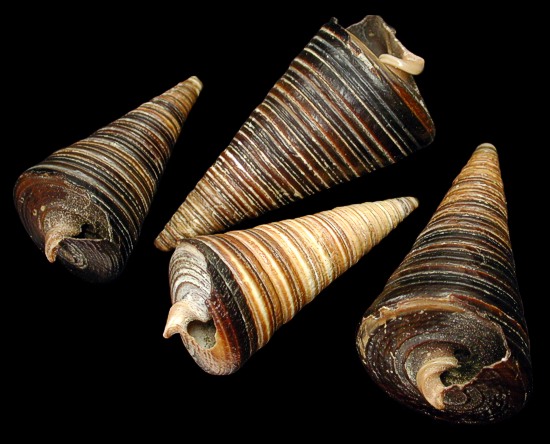As the site is updated, each listing includes the shipping cost. Some listings which I have not updated still give you calculated shipping costs based on weight and size of package. (In the sections I have updated) If you select several different listings, we will consolidate your order and charge you the actual cost of the entire package. The shipping over charge will be refunded to you, when your order is shipped.
TELESCOPE SNAIL ONE OF THE FEW HORN SNAILS
Telescope Snails belong to the Horn Shell family.
The Horn Snail Shell family (Potamididae)(gastropods) has only a few species. They are seen across the Indo-Pacific region from the Indian Ocean east to the Northern Australian/New Zealand shores. They prefer mangrove swamps and mud flats. Some species may gather in the thousands.

TELESCOPE SNAIN
Telescopium telescopium, also known as the telescope snail, belongs to the horn snail family Potamididae and inhabits mangrove environments in the Indo-Pacific region. These large snails can reach lengths of 3 to 4 inches and are distinguished by their distinctive cone-shaped shells.
Telescope snails are edible and are eaten in parts of Southeast Asia.
Telescopium telescopium snails are relatively large compared to other mollusks in the Potamididae family, with shells ranging from 3 to 5 inches at full maturity. The shell is thick and heavy in relation to the snail's body. Its opening is perpendicular to the longitudinal axis of the shell, giving it a straight-sided conical shape. The shell of Telescopium telescopium is unique among gastropods as it contains 0.12% magnesium carbonate. The operculum is rigiclaudent, which means the last growth increment lies tangentially against the labial lip of the preceding whorl, distinguishing it within the Potamididae family where shells typically have flexicaudent opercula.
Telescopium telescopium shells are typically black or a very dark reddish-brown. They are distinguished by a fold on the columella, unique to this gastropod within the Potamididae family. Although their color is quite distinct, it is often obscured by barnacles and mud, concealing their natural hue.
The Telescopium telescopium, when outside of its shell, exhibits a black exterior and a lengthy proboscis. Additionally, it possesses three eyes; one is located at the boundary of its shell, and two are situated near the protrusion of its proboscis.
The respiratory system of Telescopium telescopium operates similarly to that of other semi-tidal gastropods, extracting oxygen from water as it flows over diminutive gills situated within its shell. As the tide recedes, Telescopium telescopium retreats into its shell, conserving energy and oxygen until the return of the ebb tide, at which point it becomes active once more.
Telescopium telescopium, like all gastropods, moves using a single foot that extends from the opening of its shell. This movement is achieved through a series of muscle contractions in waves along the foot's underside, propelling the mollusk forward. The foot secretes a sticky substance called pedal mucus, which has adhesive properties that enable Telescopium telescopium to adhere to inverted surfaces, counteracting the force of gravity they would otherwise succumb to. This pedal mucus is crucial for Telescopium telescopium to remain attached during the high tide on mangrove foreshores.
The Telescopium telescopium thrives in the mangrove forests of the Indo-Western Pacific and the Indian Ocean islands, such as Madagascar and Réunion. They are typically found beneath the muddy surface of mangrove foreshores and on mudflats that are just submerged at high tide, sometimes even venturing beyond the range of the tide mark range.
Telescopium telescopium reproduces through external fertilization of eggs. The male does not possess a penis; rather, it releases sperm in packets over the eggs laid by the female. The female deposits her eggs through an opening on the right side of her foot. The details of gestation remain relatively unknown. Offspring emerge as tiny larvae in the water, feeding on phytoplankton. Before maturing into fully grown adults, they transition from larvae to juvenile veligers. Throughout its development, the Telescopium telescopium increases in length by 1.5 to 2 inches annually until it reaches full size. The lifespan of the Telescopium telescopium can extend up to 4 years.
Telescopium telescopium, commonly known as detritivores, predominantly acquire their nutrients on mangrove forest floors. Here, they feed on the abundant decomposed organic matter and surface algae left behind during the ebb tide phase of tidal movements. They also scavenge for food while completely or partially covered, with only their shell tips exposed, as a means of protection against heat, desiccation, and predators.
Telescopium telescopium, the only species of Potamididae consumed by Aborigines, is considered a delicacy due to its rarity. These snails are typically prepared by light roasting, steaming, or boiling prior to consumption. Telescopium telescopium is known for its low protein content and distinctive peppery flavor.
Scientific classification
Domain: Eukaryota
Kingdom: Animalia
Phylum: Mollusca
Class: Gastropoda
Subclass: Caenogastropoda
Family: Potamididae
Genus: Telescopium
Species: Telescopium telescopium
Binomial name: Telescopium telescopium
(Linnaeus, 1758)
(REF: MolluscaBase eds. (2021). MolluscaBase. Telescopium telescopium (Linnaeus, 1758). Accessed through: World Register of Marine Species)(REF: Australia, Atlas of Living. "Species: Telescopium telescopium (Mud Creeper)". bie.ala.org.au. Retrieved 16 May 2021.)(REF: Tryon, George (1882). "The Shell". Structural and Systematic Conchology. Vol. I)(REF: Tucker., Abbott, Robert (1991). Seashells of Southeast Asia.)(REF: Denny, Mark (1980). "The role of gastropod pedal mucus in locomotion". Nature. 285)(REF: Ariyanto, Dafit (2019). "FOOD PREFERENCE ON TELESCOPIUM TELESCOPIUM (MOLLUSCA: GASTROPODA) BASED ON FOOD SOURCES IN MANGROVE ECOSYSTEM)(REF: Melvill, James Cosmo; Standen, Robert (1901). "The Mollusca of the Persian Gulf, Gulf of Oman, and Arabian Sea, as evidenced mainly through the Collections of Mr. FW Townsend, 1893–1900; with Deacriptions of new Species". Proceedings of the Zoological Society of London. 71)
Y1-9
A Telescope Shell measuring 1 3/4 to 2.5 inches ...... .26